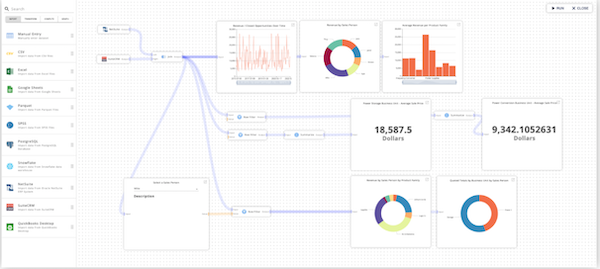Organizations are ditching side books and upping compliance audits while exploring the impact trends like AI, blockchain and augmented reality will have on their enterprise resource planning systems.
ERP systems are essential to enterprise operations. Yet this core organizational workhorse may not get as much attention as your other systems. That’s a mistake, as significant opportunities to improve cash flow and reduce risk await those who attend to the health of their enterprise resource planning systems.
Here’s a look at how organizations are revamping their use of ERP systems to improve organizational outcomes.

ERP takes aim at accounts payable
Manually processing payments to suppliers and other stakeholders can be a significant burden. Add in the rise of fraud, and you can see why there is an increasing desire to centralize accounts payable in ERP. And the rise of AI in ERP tools is helping to fuel this trend.
“We are seeing more AI and machine learning be used to make decisions on payments in the enterprise. For example, deciding when to take an early payment discount on an invoice payment is area where AI impacts ERP,” explains Mickey North Rizza, program vice president for IDC’s enterprise applications and digital commerce research practice
“We are also focusing on the universe of payments; increasingly we see companies wanting to approach payments in a centralized way so that they can make sure they are paying and receiving the right amounts,” explains Brian Shannon, SVP strategy & operations, Americas for Serrala. “While many CFOs focus on the inbound cash and cash application process, outbound payments are where cash leaves the business and provides CFOs with the greatest degree of control over corporate cash. The ability to control payments is an even greater concern for CFOs when you consider that 75 percent of all companies experienced attempted payment fraud in 2017.”
ERP is eating into Excel’s base
Like it or not, Excel remains the tool of choice for CFOs and finance departments worldwide. ERP adoption has always had a long way to go, thanks to these “side books,” but companies are finally realizing the power of moving at least some of that Excel workload to ERP systems.
Ray Rebello, director of product marketing at ERP vendor Acumatica, describes a typical scenario. “Dakota Red [an Iowa-based construction company] had separate financial report writing software and massaged data within Excel, which meant they often had to re-create reports each month manually,” he says. “They used a Microsoft Access custom program to handle POS transactions with each location having its standalone databases that included inventory.” Because this data didn’t connect to the company’s ERP system, it had to be moved over manually.
“Acumatica is an emerging ERP player that I’m watching. While other ERP vendors are going for larger companies — those over $200 million in size — Acumentica is making inroads on smaller companies in the $5 million and larger category. I also see Workday as a credible player in finance and HCM [human capital management],” explains Mike Guay, research director at Gartner who focuses on ERP technology.
Here, ERPs have an advantage, as they excel at streamlining repetitive processes such as reconciliations and reports.
“We used to use some spreadsheets and staff effort on our revenue recognition. Our month-end close took up to thirty days,” says Elliot Woo, controller at GoGuardian, which offers Chromebook management solutions that keep students safer online. “When we adopted an ERP for the first time this year, we started to close our books in a week.”
Seeking to eliminate Excel spreadsheets from finance is not a worthwhile goal, as no ERP application can entirely win over the Excel faithful. But ERP is taking over more of the routine, core processing work that used to be done in Excel.
ERP implementation remains a slog
Ask any experienced IT manager about ERP projects, and you will hear the same story over again. ERP systems are infamous for taking a long time to implement. After all, you are changing an organization’s core system. A mistake or data loss can undermine customer service and accounting, jeopardizing the health of the organization as a whole.
If you were hoping that had changed, you’re out of luck. But companies adopting an ERP system for the first time may be an exception to the “ERP projects take years” rule, thanks to industry wisdom around ERP implementation hurdles. For example, when GoGuardian adopted its new ERP system, the implementation process took approximately three months to complete. Carried out by a third-party firm, the implementation time line benefitting from not being an upgrade or transition from another ERP, Woo says.
“On-premise ERP systems often have extensive customization developed over the years. That level of customization is a barrier to adopting cloud ERP. Beyond that fact, many enterprises are locked into multi-year ERP contracts and some have declined to install new ERP upgrades,” IDC’s Rizza explains.
ERP is getting an AI/AR upgrade
ERP systems were first created for the manufacturing industry where raw materials and parts were the key resources. But as manufacturing increasingly goes digital, ERP systems are now being extended with cutting-edge tech to help drive efficiencies. Fisher Dynamics, a manufacturing company based in Michigan, has adopted Google Glass and location beacons to improve tracking of materials and workers.
“In the power generation industry we are working on a field service and procedure management application — essentially work order execution in the field that combines augmented reality (AR) and machine learning to enable technicians to do their work faster and with less probability of mistakes,” says Devbridge Group’s Aurimas Adomavicius. “It is an extension of their ERP that enables them to reach higher efficiency (wrench time), higher safety (lower chance of tripping and bringing down the plant), and higher throughput through the technician.”
In contrast to self-driving cars where decisions are made by the machine, AI in ERP is more about augmenting human decisions. “In my discussions with clients and ERP vendors, I am seeing heavy investment in AI from vendors. The focus is on augmenting and supporting a human decision maker rather than replacing them,” explains Guay. This type of weak AI — narrowly focused on a specific activity and supporting humans — is most likely to impact ERP this year.
What moves are ERP vendors taking on the market? In January 2018, Workday acquired SkipFlag for its machine learning capabilities. SkipFlag’s technology uses machine learning to build a question and answer database by analyzing a company’s data including internal communications. Given Workday’s plan to integrate SkipFlag into its product, you can expect to see a more interactive ERP in the future.
ERP vendors themselves are also injecting AI capabilities into the ERP offerings. A few early adopters in industry are adopting AI into ERP. Boston Consulting Grouphas reported an oil refinery machine learning model that uses 1,000 data points to better predict equipment failures. Once these predictions emerge from the system, it is up to management to act on the program’s predictions.
Compliance is becoming more critical for ERP
In the 2000s, ERP managers had to adapt to the rise of Sarbanes-Oxley (SOX) requirements. Those changes drove significant changes because they emphasized a new level of internal controls. Today, delivering SOX compliance in your ERP is a baseline expectation, but what about more recent regulations, such as the General Data Protection Regulation (GDPR)?
You may have already focused your GDPR compliance efforts on sales and marketing systems. But ERP systems process, store and manipulate customer information that may be in scope for GDPR. Alternatively, your ERP may fall behind compliance regulations in highly regulated industries like banking and healthcare.
Once you have identified compliance needs, ask some tough questions about how these are being managed. Do you have staff manually carrying out transactions like compliance reviews? Several of the largest ERP companies such as Epicor offer compliance-related products. When possible, use compliance add-ons from your current ERP vendor to minimize implementation complexity.
Blockchain technology is on the drawing board for ERP
Blockchain technology is gaining interest in the enterprise, and it will probably have a role to play in ERP in the future as well.
“I’m seeing increasing interest in bringing blockchain to ERP. While this is at the hype stage, there are a few interesting use cases,” comments Guay. Supply chain management is particularly promising as an application. “I’m starting to see a few use cases of using blockchain in ERP systems where traceability is important.”
In April 2018, electronics maker Samsung revealed it is looking at blockchain technology to reduce its supply chain costs. Samsung has estimated that blockchain could reduce shipping expenses by 20 percent. Will these improvements materialize? It’s too soon to tell. However, Samsung is not alone in pursuing blockchain logistics savings. Maersk, the pharmaceutical giant, announced a partnership with IBM to use blockchain for shipping. In an industry where poor product quality costs lives, blockchain-derived improvements in tracking and anti-tampering may be highly valuable.



